The hidden meanings of Destined to be Happy exhibition - The Interview with Irina Korina
10 January 2017 | By
09 January 2017 | By
Inside the Picture: Installation Art in Three Acts - by Jane A. Sharp
19 November 2016 | By
Conversations with Andrei Monastyrski - by Sabine Hänsgen
17 November 2016 | By
Thinking Pictures | Introduction - by Jane A. Sharp
15 November 2016 | By
31 October 2016 | By
Tatlin and his objects - by James McLean
02 August 2016 | By
Housing, interior design and the Soviet woman during the Khrushchev era - by Jemimah Hudson
02 August 2016 | By
Dressing the Soviet Woman Part 3: "Are Russians Women?" Vogue on Soviet Vanity - by Waleria Dorogova
18 May 2016 | By
Dressing the Soviet Woman Part 1 - by Waleria Dorogova
13 May 2016 | By
Eisenstein's Circle: Interview With Artist Alisa Oleva
31 March 2016 | By
Mescherin and his Elektronik Orchestra - by James McLean
13 January 2016 | By
SSEES Centenary Film Festival Opening Night - A review by Georgina Saunders
27 October 2015 | By
Nijinsky's Jeux by Olivia Bašić
28 July 2015 | By
Learning the theremin by Ortino
06 July 2015 | By
Impressions of Post- Soviet Warsaw by Harriet Halsey
05 May 2015 | By
Facing the Monument: Facing the Future
11 March 2015 | By Bazarov
'Bolt' and the problem of Soviet ballet, 1931
16 February 2015 | By Ivan Sollertinsky
Some Thoughts on the Ballets Russes Abroad
16 December 2014 | By Isabel Stockholm
Last Orders for the Grand Duchy
11 December 2014 | By Bazarov
Rozanova and Malevich – Racing Towards Abstraction?
15 October 2014 | By Mollie Arbuthnot
Cold War Curios: Chasing Down Classics of Soviet Design
25 September 2014 | By
Walter Spies, Moscow 1895 – Indonesia 1942
13 August 2014 | By Bazarov
'Lenin is a Mushroom' and Other Spoofs from the Late Soviet Era
07 August 2014 | By Eugenia Ellanskaya
From Canvas to Fabric: Liubov Popova and Sonia Delaunay
29 July 2014 | By Alex Chiriac
My Communist Childhood: Growing up in Soviet Romania
21 July 2014 | By Alex Chiriac
Monumental Misconceptions: The Artist as Liberator of Forgotten Art
12 May 2014 | By Rachel Hajek
28 April 2014 | By Rachel Hajek
An Orgy Becomes a Brawl: Chagall's Illustrations for Gogol's Dead Souls
14 April 2014 | By Josephine Roulet
KINO/FILM | Stone Lithography Demonstration at the London Print Studio
08 April 2014 | By Alex Chiriac
24 March 2014 | By Renée-Claude Landry
Book review | A Mysterious Accord: 65 Maximiliana, or the Illegal Practice of Astronomy
19 March 2014 | By Rosie Rockel
Leading Ladies: Laura Knight and the Ballets Russes
10 March 2014 | By Bazarov
Exhibition Review | Cash flow: The Russian Pavilion at the 2013 Venice Biennale
03 March 2014 | By Rosie Rockel
24 February 2014 | By Ellie Pavey
Guest Blog | Pulsating Crystals
17 February 2014 | By Robert Chandler Chandler
Theatre Review | Portrait as Presence in Fortune’s Fool (1848) by Ivan Turgenev
10 February 2014 | By Bazarov
03 February 2014 | By Paul Rennie
Amazons in Australia – Unravelling Space and Place Down-Under
27 January 2014 | By Bazarov
Exhibition Review | Siberia and the East, fire and ice. A synthesis of the indigenous and the exotic
11 December 2013 | By Nina Lobanov-Rostovsky
Shostakovich: A Russian Composer?
05 December 2013 | By Bazarov
Marianne von Werefkin: Western Art – Russian Soul
05 November 2013 | By Bazarov
Chagall Self-portraits at the Musée Chagall, Nice/St Paul-de-Vence
28 September 2013 | By Bazarov
31 July 2013 | By Richard Barling
Exhibition review | Lissitsky — Kabakov: Utopia and Reality
25 April 2013 | By Richard Barling
Exhibition review | Ilya and Emilia Kabakov: The Happiest Man
18 April 2013 | By Richard Barling
11 March 2015 | By Bazarov
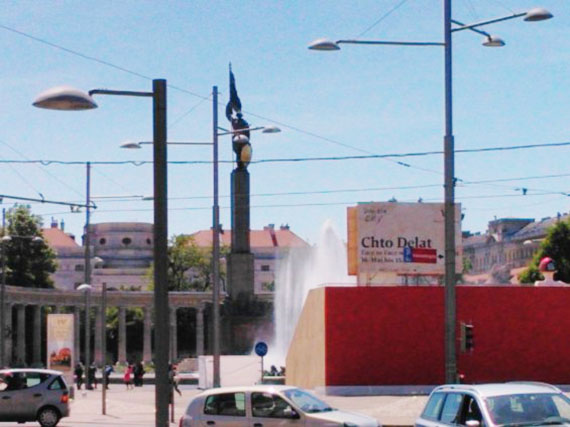
This phrase echoes through recent Russian history, and was adopted in 2003 by a workgroup of artists and writers in St Petersburg with the aim of redefining the foundations of cultural practice in post-Soviet society.
Stimulated by the GRAD lab project, a new platform in London exploring arts and the built environment, Bazarov has revisited some scenes from his brief visit to Vienna in May 2014. In the most conspicuous possible position, at the head of the Schwartzenbergplatz adjoining Vienna’s famous ‘Ring’, two monumental constructions faced up to each other in a bold dialectic of commemoration and confrontation, immortality and impermanence, created as part of the Wiener Festwochen.
The Soviet War Memorial (Heldendenkmal der Roten Armee) was erected in 1945 following the capture of Vienna under Stalin’s orders, as a colossal geopolitical statement that was also a shrine to 17,000 Soviet soldiers lost in the battle for Vienna. A colonnade, a fountain, and the crowning figure of a soldier with a submachine gun and holding a Soviet flag define the aggressive solemnity of the work. Always controversial, given the license shown by liberating Soviet soldiers, the Memorial was visited by Russian President Vladimir Putin in 2007 to show gratitude to the city for having saved the structure from demolition.
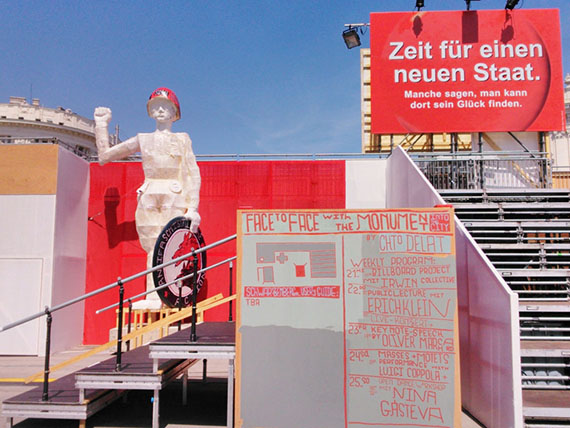
The unknown Soviet soldier stands today above the traffic of Westernised, consumerist Vienna, a hubristic symbol of triumph and possession or a calculated affront according to the viewer’s cultural and political persuasion.
For a brief perio hubris met nemesis, in the form of a temporary installation by Chto Delat. Face to Face with the Monument, a participatory and crudely assembled artistic ‘event’, was designed to challenge the memorialization and tacit endorsement of war as a political instrument. In garish mimicry of Soviet red, a helmeted androgynous figure raises a fist in the direction, and in the exact axis, of the Memorial. Her shield carries not a coat of arms but a pack of wolves, The rakish transience of Face to Face, with its handwritten texts and DIY materials, is a parody of the classical forms opposite, of the columns and statuary and cast metal fonts that commemorate the Soviet presence.
In common with the GRAD lab project, changing artistic displays, performances, lectures and workshops were part of the Face to Face artistic programme. Such fleetness of foot perhaps seemed the only way to challenge the changeless solidity of the Memorial, which has, nevertheless, been defaced in common with Soviet-era monuments in many cities of Eastern Europe.
Some have argued that Soviet monuments should be preserved as reminders of the extent of the Russian sacrifice in the defeat of Hitler’s Nazism, which proposed the colonialisation and eventual elimination of the Slavic peoples.
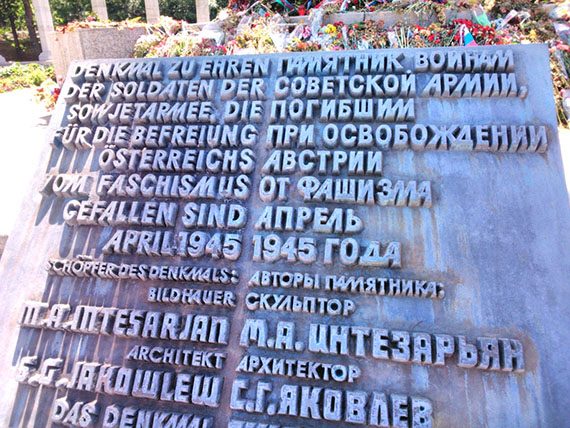
In many parts of the former Soviet Union, however, monuments have been toppled or defaced. These structures, in their material solidity, challenge the freedoms now enjoyed from the Baltics to Bulgaria, even if they perhaps provide some residual reassurance to Russian speaking citizens of the post-Soviet states. In Tallinn, in 2007, riots between Russian and Estonian speakers were provoked by the removal of a Red Army memorial. And in Kirkeness, on Norway’s border with Russia, Bazarov has observed respectful tributes being paid to another such monument.
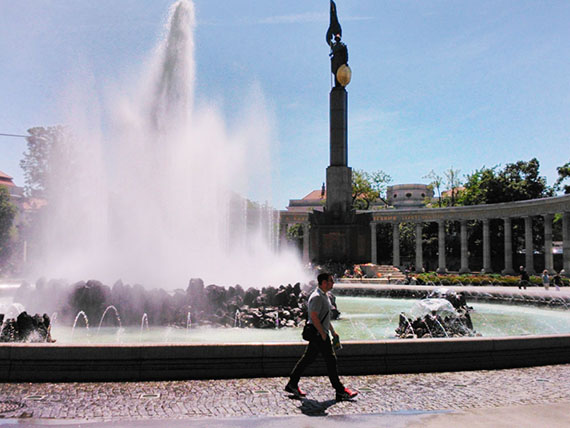
Strangely, the vibrant construction of Chto Delat in Vienna, and its mighty Soviet partner, created a momentary unity which was as transient as it was unexpected, at least to this observer. A dance, in the city of the waltz, between the pleasures of impermanence and the solidity of duty, perhaps. The privilege of a summer of self-expression versus a command to retake and retain at any cost. Neither work seemed to me to be diminished by the confrontation, and the fountains played as if for participants on both sides of Europe’s enduring cultural fracture line.
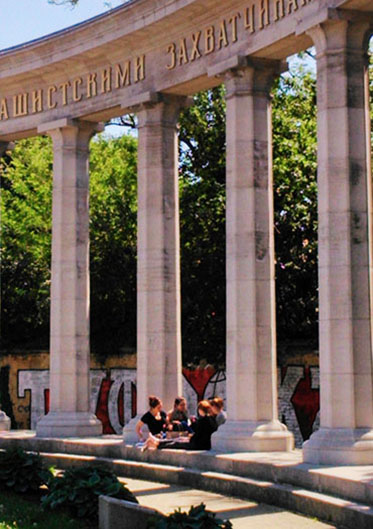
Beneath the encircling colonnade, young people of who knows what nationality, in this most liminal of cities, enjoyed a picnic, apparently oblivious both to the commemorative Cyrillic lettering in gold above their heads and to the graffiti slogans providing a theatrical backdrop to their lunch. For the young there is always a future, and Chto Delat, in their strident and irreverent Viennese installation, seem perhaps to prepare the way.
All images courtesy of Bazarov, February 2015


